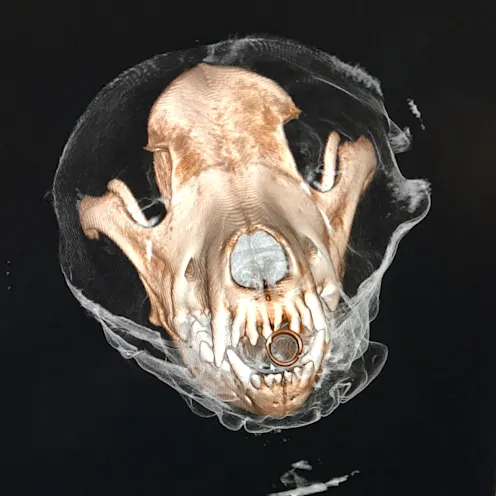Eagle Animal Hospital
Effective diagnostic test for understanding and evaluating abnormalities or injuries
Veterinarians can identify the precise location of a tumor, growth, or injury
Helps your vet identify or rule out canine and feline cancers
Helps veterinarians understand orthopedic abnormalities
Assists in planning for corrective procedures such as TPLO surgery and other orthopedic procedures
Helpful for identifying and treating dental issues
Essential for diagnosing and facilitating treatments for various injuries
CT Scanning
A CT scan (Computed Tomography Scan) allows veterinarians to look closer at a pet’s internal body parts, including tissues, muscles, bones, and organs. This type of diagnostic imaging for pets is incredibly valuable when veterinarians suspect a problem that they cannot see on the on the outside of an animal or in an X-ray. CT scanning provides a way for veterinarians to get a fuller picture of what’s going on inside your pet’s body, so they can examine and evaluate the findings in order to properly diagnose a condition or abnormality. Then, using the findings from the CT scan, our veterinarians can determine the most effective treatment plan to address your pet’s condition.
FAQs
What is CT Scanning?
This type of veterinary radiology is similar to that of X-ray scans, in that it can be used to view extremely small areas in a dog or cat’s body by transforming the small images taken in slices into larger three-dimensional views, which can then be studied by veterinary radiologists and veterinarians. CT scanning can be used to examine any body part through CT imaging.
How are CT Scans performed?
CT scanning for pets is similar to CT scans for people. While the patient is on the table that is slid into the CT imaging machine, they must remain completely still throughout the entire imaging procedure in order to capture a clear, precise image. Therefore, a dog or cat must be placed under a general anesthesia so they stay still. If a veterinarian wants to gain an enhanced view of a pet’s soft tissues and blood vessels, the patient may be injected with a safe contrasting agent or dye that shows a clear contrast in the final image.
Once the process begins, radiographic images are taken from numerous angles while the patient’s body passes through the CT machine. A veterinarian may request images for a specific body part or area, or they may request a full body scan. Typically, CT scans take anywhere from 15-45 minutes to complete. Once the images have been gathered, a veterinary radiologist will manipulate and reconstruct the images, which will then be evaluated and used to make a diagnosis.
Contact Our Top Rated Local Pet Imaging Specialists
If your pet requires CT scanning, give our animal hospital a call to arrange an appointment for your precious furry family member. At Eagle, our goal is to help your pet live a healthy, happy life. Our specialized services such as pet imaging, laparoscopic surgery, and other diagnostic imaging services can help our veterinary specialists identify, diagnose, and treat your pet’s condition with the utmost care, compassion, and experience. Give us a call today or reach out to us online.








